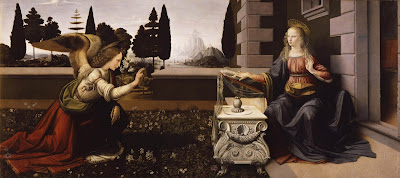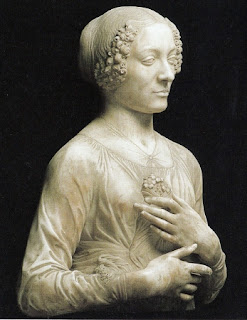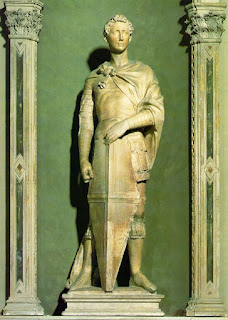Edward Hutton ended his tour of the Bargello, the sculpture gallery in Florence, with a discussion of Michelangelo, "that beautiful, strong and tragic soul." Michelangelo's most famous works are not in the Bargello but there was still the figure of the Greek god Bacchus, the great Roman Brutus, a lovely relief of the Madonna and Child, as well as a Pieta apparently intended for his own tomb.
There follows Michelangelo (1475-1564). It is with a sort of surprise that one comes fact to face with that sorrowful, heroic figure, as though, following among the flowers, we had come upon some tragic precipice, some immense cavern too deep for sight. How, after the delight, the delicate charm of the fifteenth century, can I speak of this beautiful, strong, and tragic soul? It might almost seem that the greatest Italian of the sixteenth century has left us in sculpture little more than an immortal gesture of despair, of despair of a world which he has not been content to love. His work is beautiful with the beauty of the mountains, of the mountains of which he alone has found the spirit of man. His figures, half unveiled from the living rock, are like some terrible indictment of the world he lived in, and in a sort of rage at its uselessness he leaves them unfinished, and it but half expressed;--an indictment of himself too, of his own heart, of his contempt for things as they are. Yet in his youth, he had been content with beauty—in the lovely Pieta of S. Pietro, for instance, where, on the robe of Mary, alone in all his work he has placed his name; or in the statue of Bacchus, now here in the Bargello, sleepy, half drunken with wine or with visions, the eyelids heavy with dreams, the cup still in his hand. But already in the David his trouble is come upon him; the sorrow that embittered his life has been foreseen, and in a sort of protest against the enslavement of Florence, that nest where he was born, he creates this hero, who seems to be waiting for some tyranny to declare itself.
The Brutus, unfinished as we say, to-day in the Bargello, he refused to touch again, since that city which was made for a thousand lovers, as he said, had been enjoyed by one only, some Medici against whom, as we know, he was ready to fight. If in the beautiful relief of Madonna we find a sweetness and strength that is altogether without bitterness or indignation, it is not any religious consolation we find there, but such comfort rather as life may give when in a moment of inward tragedy we look on the stars or watch a mother with her little son. …
The unfinished Pieta in the Duomo, it is said, he carved for his own grave: like so much of his great tragical work, it is unfinished, unfinished though everything he did was complete from the beginning. For he is like the dawn that brings with it noon and evening, he is like the day which will pass into the night. In him the spirit of man has stammered the syllables of eternity, and in its agony of longing or sorrow has failed to speak only the word love. All things particular to the individual, all that is small or of little account, that endures but for a moment, have been purged away, so that Life itself may make, as it were, an immortal gesticulation, almost monstrous in its passionate intensity—a mirage seen on the mountains, a shadow on the snow. And after him, and long before his death, there came Baccio Bandinelli and the rest, Cellini the goldsmith, Giovanni da Bologna, and the sculptors of the decadence that has lasted till our own day. With him Italian art seems to have been hurled out of heaven; henceforth his followers stand on the brink of Pandemonium, making the frantic gestures of fallen gods.
###
Edward Hutton: Florence and Northern Tuscany with Genoa, second edition, London, 1908. Pp. 296-7.












